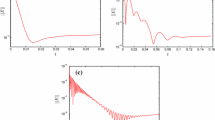Abstract
Discontinuous Galerkin (DG) and central DG methods are two related families of finite element methods. They can provide high order spatial discretizations that are often combined with explicit high order time discretizations to solve initial boundary value problems. In this context, it has been observed that the central DG method allows larger time steps, especially for schemes with high accuracy. In this paper, we estimate bounds for the DG and central DG spatial operators for the linear advection equation. Based on these estimates and Kreiss-Wu theory, we obtain time step conditions to ensure the numerical stability of the DG and central DG methods when the methods are combined with locally stable time discretizations. In particular, for a fixed time discretization, the time step allowed for the DG method is proportional to \(h/k^2\), while the time step allowed for the central DG method is proportional to \(h/k\), where \(h\) is the spatial mesh size and \(k>0\) is the polynomial degree of the discrete space of the spatial discretization. In addition, the analysis provides new insight into the role of a parameter in the central DG formulation. We verify our results numerically, and we also discuss extensions of our analysis to some related discretizations.










Similar content being viewed by others
References
Chalmers, N., Krivodonova, L., Qin, R.: Relaxing the CFL number of the discontinuous Galerkin method (2012, preprint)
Cockburn, B.: An introduction to the discontinuous Galerkin method for convection-dominated problems. Adv. Numer. Approx. Nonlinear Hyperbolic Equ. Lecture Notes in Mathematics 169, 151–268 (1998)
Cockburn, B., Shu, C.-W.: Runge Kutta discontinuous Galerkin methods for convection-dominated problems. J. Sci. Comput. 16(3), 173–261 (2001)
Gottlieb, S., Shu, C.-W., Tadmor, E.: Strong stability-preserving high-order time discretization methods. SIAM Rev. 43, 89–112 (2001)
Kreiss, H.O., Scherer, G.: Method of lines for hyperbolic differential equations. SIAM J. Numer. Anal. 29(3), 640–646 (1992)
Kreiss, H.O., Wu, L.: On the stability definition of difference approximations for the initial boundary value problem. Appl. Numer. Math. 12, 213–227 (1993)
Levy, D., Tadmor, E.: From semi-discrete to fully-discrete: stability of Runge-Kutta schemes by the energy method. SIAM Rev. 40, 40–73 (1998)
Li, F., Xu, L.: Arbitrary order exactly divergence-free central discontinuous Galerkin methods for ideal MHD equations. J. Comput. Phys. 231, 2655–2675 (2012)
Liu, Y.J., Shu, C.-W., Tadmor, E., Zhang, M.: Central discontinuous Galerkin methods on overlapping cells with a non-oscillatory hierarchical reconstruction. SIAM J. Numer. Anal. 45, 2442–2467 (2007)
Liu, Y.J., Shu, C.-W., Tadmor, E., Zhang, M.: \(L^2\) stability analysis of the central discontinuous Galerkin method and a comparison between the central and regular discontinuous Galerkin methods. ESAIM: Math. Model. Numer. Anal. 42, 593–607 (2008)
Reed, W., Hill, T.: Triangular Mesh Methods for the Neutron Transport Equation. Technical report, Los Alamos, NM (1973)
Sansone, G.: Orthogonal Functions. Dover Publications Inc, Mineola (2004)
Xu, Z.L., Chen, X.-Y., Liu, Y.J.: A new Runge-Kutta discontinuous Galerkin method with conservation constraint to improve CFL condition for solving conservation laws (2014, preprint)
Warburton, T., Hagstrom, T.: Taming the CFL number for discontinuous Galerkin methods on structured meshes. SIAM J. Numer. Anal. 46, 3151–3180 (2008)
Author information
Authors and Affiliations
Corresponding author
Additional information
Supported in part by NSF-RTG Grant DMS-0636358 as a Research Assistant. Supported in part by NSF CAREER award DMS-0847241 and NSF DMS-1318409.
Appendices
Appendix 1
In this “Appendix”, we illustrate how to find \(\tilde{C}_{1,k}\) for use in (10) as described in Sect. 4.1. More specifically, for any \(k\ge 0\), we want to find \(\tilde{C}_{1,k}\) such that
for any \(p\in P^k([-1,1])\). By inspection, we see that \(\tilde{C}_{1,0}=0\), so we consider \(k\ge 1\). We can represent any \(p\in P^k([-1,1])\) uniquely as \( p(x)=\sum _{j=0}^k\alpha _j\tilde{L}_j(x), \) where \(\{\tilde{L}_j(x)\}_{j=0}^k\) are the Legendre polynomials normalized so that \({\Vert \tilde{L}_j\Vert }_{L^2([-1,1])}=1\). We let \(\alpha =(\alpha _j)\in {\mathbb R}^{k+1}\) denote the coefficient vector, and we let \(A_k=\left( a_{ij}\right) \in {\mathbb R}^{(k+1)\times (k+1)}\), where
We note that \(A_k\) is a symmetric positive semi-definite matrix, and, in addition, that
Accordingly, we see that
where \(\lambda _{\mathrm {max}}(A_k)\ge 0\) is the largest eigenvalue of \(A_k\), so we have
The process of finding \(\tilde{C}_{2,k}\), \(\tilde{C}_{3,s,k}\), and \(\tilde{C}_{4,s,k}\) for use in (11), (12), and (13), respectively, is similar.
Appendix 2
To illustrate how the local mesh regularly will affect the estimate in (21) for the central DG spatial operator on general meshes, we consider a quasi-uniform mesh with
for any \(j\), and \(\sigma \in (0,1]\). For such mesh, \(\rho _{j+\frac{1}{2}}=\sigma \) for all \(j\), and \(\sigma =1\) corresponds to a uniform mesh. In Table 5, we report the value of
for different \(\sigma \) and \(k\), where the constants \(C_{3, s}\) and \(C_{4,s}\) are replaced by \(\tilde{C}_{3, s, k}\) and \(\tilde{C}_{4, s, k}\) as described in Sect. 4.1 and “Appendix 1”. From the results, one can see that the value of \(\Xi (k;\sigma )\) is not affected dramatically by the local mesh regularity.
Rights and permissions
About this article
Cite this article
Reyna, M.A., Li, F. Operator Bounds and Time Step Conditions for the DG and Central DG Methods. J Sci Comput 62, 532–554 (2015). https://doi.org/10.1007/s10915-014-9866-5
Received:
Revised:
Accepted:
Published:
Issue Date:
DOI: https://doi.org/10.1007/s10915-014-9866-5




